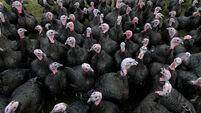Most poetic flower of the bunch
forgetting
It was a grey, mean-spirited sort of day. A cold easterly wind drove squalls of rain hard against the conservatory roof. All the lights had been turned on because it was so gloomy and I’d set the fire unusually early.
The only sensible thing seemed to be to stay put for the day, especially since this was in that no-man’s land which exists between Christmas and New Year.
But for once I had remembered to empty the fridge before we left for the Christmas break, in order to avoid returning to scarey-looking onions with long green tentacles and brightly coloured fungi. The cupboard was bare and there were mouths to be fed. So there was nothing for it but to head into town to stock up. Normally this isn’t a trip I mind since Bantry is hardly a taxing place to shop. But on this day I felt cross, resentful at being forced into action of any kind.
People scuttled about the streets with their heads down and supermarket shelves had the look of having recently been raided by gangs of desperate survivalists. I grabbed a basket and began to wander morosely down the aisles until, that is, I spotted a bucket that positively glowed with sunshine, and bonhomie.
Daffodils! Lots of daffodils in pre-packed bunches, their golden glow making you think suddenly of warmth, Easter, spring lambs and rebirth, no matter how bad your mood might have been.
And it was only a few days after Christmas.
I felt instantly cheered, bolstered and almost guilty for my earlier bad mood. After all, why be downhearted when spring was so obviously just around the corner? And even if that wasn’t exactly true, still the arrival of the first daffodils has always inspired hope.
I took several bunches home and distributed them around the house, marvelling on how they seemed to light up even the gloomiest corner. And since I had a few post-Christmas visits to make, I decided not to take chocolates, mince pies or anything else that was associated with the over-indulgence we had all so enjoyed. I would take daffodils instead. The bright flowers were a huge hit.
So just what is it about these sturdy blooms that make them so well loved and the inspiration for poetic flights of fancy from the likes of Shelley, Wordsworth, e.e.cummings and so many more? Another poet, Linda Burns, has an answer I like:
There are many varieties of daffodils, which are all of the genus Narcissus. First introduced into gardens at around 300 BC, the Greek botanist Theophrastus described many of the earliest varieties in his nine-volume Enquiry Into Plants, Narcissus Poetica was one of the first daffodils to be cultivated and is often associated with the Greek legend of that dreamy boy who became enamoured of his own beauty and who was subsequently punished for his folly by Nemesis, the Goddess of Vengeance.
Narcissus poeticus has long since hybridised with the wild British daffodil and these older heritage hybrids, those ten thousand dancing hosts which so enchanted Wordsworth, are considered more elegant and graceful than their modern counterparts.
But today many growers cherish the older varieties too, daffodils with wonderful names such as King Alfred, Sir Watkin and the ice-white Beersheba.
Of course, if you are growing daffodils commercially, it’s a lot more than a matter of throwing in a few bulbs in the autumn then sitting back and watching them proliferate. I asked Brian Perrott, West Cork grower of the daffodils I had recently bought, just how he managed to produce his blooms so early.
*It was lovely to see them in shops so soon after Christmas, Brian. Does it take much to get blooms so early in the year?
>>“It’s all a question of what species you plant. And if you are growing commercially, then it’s obviously important that you have a succession of flowering, starting from about this time of the year. And like any other crop, you have to find out what species suits your soil and your growing conditions. And that takes time.”
*Have you been affected by the bad weather?
>>To a certain extent, yes. The condition of the ground is atrocious and our production of bulbs is down. But we are lucky. Daffodils are fairly hardy once they are growing in conditions they like. We have 60 acres in production. Changes in temperature can slow down or speed up a certain species so it’s a question of keeping a balance so you can extend the season.”
*Is the selling season long, and where is your best market?
>>“We continue through April into May and we sell a certain amount of our flowers and bulbs abroad. I work exclusively on the daffodils for 11 months of the year. We are very keen on promoting Irish daffodils. Until quite recently Marks and Spencer’s Ireland used to buy their daffs from abroad. But now they buy from us. They make fabulous displays of the flowers on checkout stands and in other locations. I’d like to see that sort of thing in every store.”
*Are daffodils as popular here as they are in the UK?
>>“No, definitely not. I think the figures are something like 60 million daffodils sold in the UK annually, and two million here. And I can’t think why because they are a fabulous flower, with so many varieties to choose from. There’s even a pink daffodil on the market now. And they are really good value for money too.”










